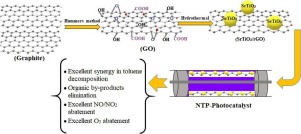Journal of Photochemistry and Photobiology A: Chemistry ( IF 4.1 ) Pub Date : 2020-03-05 , DOI: 10.1016/j.jphotochem.2020.112460 Pejman Mohammadi , Farshid Ghorbani-Shahna , Abdulrahman Bahrami , Amir Abbas Rafati , Maryam Farhadian

|
In this study, toluene degradation was studied in a combined plasma-photocatalytic system using the SrTiO3/rGO as photocatalyst. The photocatalyst was combined with Non-Thermal Plasma (NTP) to improve the performance of NTP in terms of increased toluene removal efficiency (RE) and lower by-products formation. SrTiO3/rGO was synthesized through the simple hydrothermal method and characterized by XRD, FESEM-EDX, UV–vis DRS, and FTIR. Toluene degradation was performed in dynamic mode taking into account the effects of gas flow rate, toluene concentration, relative humidity (RH), and discharge power on the toluene RE. Interactions between the process parameters and optimization of the toluene removal in the plasma-photocatalytic system were investigated by central composite design (CCD). Results showed that Maximum RE of 100 % was obtained at 0.3 L/min flow rate, 61 % RH, 100 ppm initial concentration, and 291 w discharge power. An excellent synergistic effect was observed by combining the NTP with SrTiO3/rGO so that the toluene RE in the NTP-Photocatalytic system at 187.5 w discharge power was almost equal to RE obtained at 292 w discharge power in the NTP alone system. The introduction of SrTiO3/rGO also removed the organic by-products (benzaldehyde, benzoic acid, formic acid, and acetic acid) produced by NTP and improved the CO2 selectivity.
中文翻译:

使用SrTiO 3 / rGO作为副产物减少和协同效应的有效异质结,进行等离子体光催化降解气态甲苯
在这项研究中,使用SrTiO 3 / rGO作为光催化剂,在等离子体-光催化组合系统中研究了甲苯的降解。将光催化剂与非热等离子体(NTP)结合使用,以提高甲苯去除效率(RE)和降低副产物形成的方式改善NTP的性能。钛酸锶3/ rGO通过简单的水热法合成,并通过XRD,FESEM-EDX,UV-vis DRS和FTIR进行表征。考虑到气体流速,甲苯浓度,相对湿度(RH)和放电功率对甲苯RE的影响,以动态模式进行甲苯降解。通过中央复合设计(CCD)研究了工艺参数与等离子体光催化体系中甲苯去除的优化之间的相互作用。结果表明,在0.3 L / min的流量,61%的RH,100 ppm的初始浓度和291 w的放电功率下,可获得100%的最大RE。通过将NTP与SrTiO 3结合使用,观察到了优异的协同作用/ rGO,因此在NTP光催化系统中,在187.5 w放电功率下的甲苯RE几乎等于在单独NTP系统中在292 w放电功率下获得的RE。SrTiO 3 / rGO的引入还去除了NTP产生的有机副产物(苯甲醛,苯甲酸,甲酸和乙酸),并提高了CO 2的选择性。











































 京公网安备 11010802027423号
京公网安备 11010802027423号